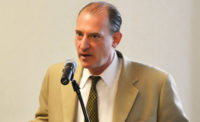ESA’s annual Day on Capitol Hill took place May 16 and 17, during which time security industry representatives visited nearly 100 U.S. House and U.S. Senate Congressional offices to discuss topics pertinent to the security issue and develop communication and relationships with lawmakers.
ESA members met with many of their elected officials, including Rep. Harper (R-MS), Rep. Hudson (R-TX), Rep. Duncan (R-TN), Sen. Scott (R-SC), Sen. Young (R-IN), Sen. Donnelly (D-IN) as well as Sen. Wicker (R-MS). Rep. Chris Collins (R-NY) was the guest speaker at the ESA luncheon at the Capitol Hill Club, ESA reported.
During the two days, attendees were able to schedule time with their politicians and express concerns and advocate for things important to the security issue.
“The objectives of the event every time we hold it are always to ensure that the voices of ESA members are represented on Capitol Hill,” said Shannon Murphy, vice president sales and marketing, ESA. “We schedule meetings with Senators, Congressmen and their staff, and we have our members fully prepared to meet with them and make sure that anything happening on Capitol Hill has their voices included in it. So if any bills are pending or any legislation is happening that could positively affect our members, we want to show support for that. And if there is something that could be onerous, we obviously want to make sure that our elected officials understand how that could negatively impact our member businesses.”
Murphy said there was really just one day in which ESA members were meeting with officials and called the event “very productive in a very short period of time.”
One of the priority issues ESA members discussed with their respective members of Congress was ESA’s strong support for reauthorization of the Perkins Act, which provides federal funding for career and technical education (CTE) of high skill, high demand jobs including the electronic security industry. During ESA members’ visits to Congressional offices on May 17, the House Education and the Workforce Committee unanimously passed HR 2353, which reauthorizes funding of the Perkins Act with more than $1.1 Billion per year through fiscal year 2023 to support CTE initiatives at the state and local level. A similar bill passed the House in 2016 with overwhelming bi-partisan support, but failed to pass the Senate.
ESA reported that in 2016 it implemented a new and more robust strategy as it relates to legislative and regulatory advocacy at the state level. Last year, ESA contacted chapters and/or national company members on more than 70 bills or proposed regulations of the 250 bills that were tagged for monitoring. ESA worked with member companies on significant legislation in Arizona, Arkansas, California, Connecticut, Delaware, Illinois, Indiana, Kentucky, Louisiana, Maine, Massachusetts and New Jersey, along with others. In this process, ESA monitored and informed chapters about 33 bills in 18 states that addressed carbon monoxide and alarm requirements. ESA also kept chapters apprised of 14 bills in 10 states that provided for video monitoring in long-term care, daycare or schools settings.
At the federal level, ESA works with its proactive government relations committee and its director of government relations to represent the interests of its members before the U.S. Congress, national coalitions, and U.S. Government agencies. During 2016, 43 bills that ESA monitored and disseminated to members were enacted into law, all of which have some level of impact on the security industry.
ESA provided attendees with talking points to help them better address issues and answer questions they might receive. ESA shared some of its talking points from this year’s Day on Capitol Hill:
- The eventual rewrite of the Telecommunication Act of 1996 and other telecommunication legislation or regulations is very important to the electronic security and life safety industry.
- ESA supports the development of performance-based standards to ensure communications paths, including VoIP paths, are reliable, robust and provide a standard of measurable quality.
- On March 9, 2017 ESA presented a Notice of Ex Parte comments to the Federal Communications Commission regarding concerns for the communication pathways and the need to maintain a competitive market place considering the great potential for market inequities.
- ESA supports continuing adherence to the National Fire Protection Association (NFPA) minimum standards on battery backup requirement for life safety systems for emerging communication technology.
- The alarm industry protects the life, safety and property of some 30 million homes and businesses. We are the largest providers of Personal Emergency Response Systems that protect seniors.
- We are an integral part of the public safety network, and play a key role in emergency response during a national emergency such as 9/11, or natural disasters such as hurricanes, tornados, and earthquakes. We work closely with the police, fire, and emergency medical responders to ensure prompt dispatch of emergency personnel.
Murphy said a lot of the work done at ESA’s Day on Capitol Hill is about building relationships and getting those Congressmen and Senators familiar with the security industry and what security professionals are doing every day.
“Even if a bill isn’t pushed through because of one of our meetings, having that information and relationship before there is an issue that our industry might have to get involved with is really important,” Murphy said. “There are thousands of bills every year that could positively or negatively impact our industry, so that is something we are staying on top of.”
ESA monitors legislative issues in all 50 states for the benefit of the industry and, specifically, its members.





